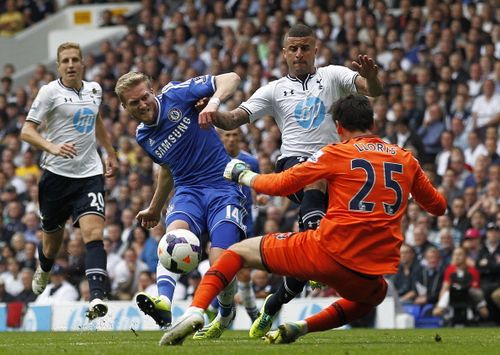
Andre Villas-Boas' high line is a courageous adventure

Andre Villas-Boas played a high line with great success at Porto
Tottenham Hotspur have had a reasonably good start to the season, yet after West Ham’s demolishing the North London club on Sunday, there is an overwhelming feeling that they will be once again fall short of their aspirations in a what should be a tightly contested league season.
One of the biggest features of an Andre Villas-Boas side is a defence that attempts to catch opposition attackers in an offside trap by maintaining a very high line. It’s not any regular high line used by most managers in Europe, hell no. This is a ridiculously high line that leaves no margin for error at all. You could go on and even christen it as “The AVB Line”.
Villas-Boas’s high-line was a very rewarding tactic at Porto, where he conquered everything that came before him.
The strategy involves the defence defending near the half line most of the game with a lot of space between the last man in defence and the goalkeeper. In this system, the goalkeeper isn’t merely a goalkeeper. He has a much bigger role in the team.
AVB tends to model his goalkeepers on Gyula Grosics, the wonderful Hungarian custodian in the 1950s. Helton at Porto was a sweeper-keeper. He made as many saves inside the box as he made clearances outside it. This approach is used to cover up the space between the defence and the keeper.
The young Portuguese manager tried to replicate that style at Chelsea but to no avail. Defenders like John Terry and Alex didn’t really have the pace to track back when caught out of position, whilst David Luiz’s playing style was always a calamity in a structure that allows minimal errors.
Going to Naples and playing a high-line against an attack that consisted of Marek Hamsik, Ezequiel Lavezzi, and Edinson Cavani proved to be the final nail in the coffin for AVB, as his Chelsea reign ended just days later after a loss at the hands of West Bromwich Albion.
Just four months later, after looking at players in Brazil and working on his tan in the Maldives, AVB was back in London. This time, in-charge of Chelsea’s rivals Tottenham Hotspur, a club that has underachieved over best part of the last century.
One of the first things AVB did at Spurs was to buy French goalkeeper Hugo Lloris from Lyon. Brad Friedel, at his age, was definitely not the right goalkeeper to play a sweeper-cum-keeper role. Hugo Lloris, on the other hand, is a very agile keeper who thrives on rushing out of his line.
In this season so far, Tottenham have conceded 5 goals, three of them in one half against West Ham. Looking at the five goals, you could say that Olivier Giroud’s goal in Arsenal’s 1-0 victory did not have much to do with Tottenham’s high line but every goal since, and you can find a connection.
If you observe closely, Lloris not only rushes when his defence is caught out but he is also very quick to latch on to crosses from open play or set-pieces. Lloris’s major weakness before joining Spurs was perhaps his inability to be decisive on crosses but all that has changed over the last year.
Looking at the four goals Tottenham have conceded, besides Giroud’s effort:
John Terry: Firstly, this goal came apart from a free kick high up the pitch where Ramires threatened to race past the Tottenham defence near the half way line. Jan Vertoghen promptly fouled him in a professional manner to give away the free kick. What followed was a superbly crafted in ball from Juan Mata, which a “free” John Terry put past a hapless Lloris. Free was emphasized on, because Terry’s marker from Tottenham just let him without even making much of an attempt. Was this because he expected Lloris to come and claim the ball? The French captain usually does.
Winston Reid: This time around, it was Winston Reid who took advantage of Lloris not coming out at a set-piece and scored from a corner to begin the riot as the Tottenham defence imitated The Statue of Liberty.
Ricardo Vaz Te and Ravel Morrison: Both these goals were classic examples of taking maximum advantage of a high line back whilst playing on the counter. Sam Allardyce had done his homework and it paid rich dividends for West Ham, as they registered a historic victory at White Hart Lane.
In addition to those three goals, Lloris was very lucky to not get sent off against Cardiff City when he rushed out to make a clearance outside the box and handled the ball. That was a direct consequent of his defence being caught high up again.

Hugo Lloris (R) rushes out to stop Andre Schurrle from scoring for Chelsea
The AVB Line might have its disadvantages but there sure are benefits too. When it clicks, it’s brilliant, as evident from the fact that Spurs conceded just two goals in 11 games in all competitions before Sunday.
Villas-Boas will no doubt continue using a high-line in defence. He has every reason to, looking at how efficacious it proved for him at Porto and for Barcelona’s success over the last years.
Just like most things in football, a high line has its perks and defects. AVB just has to make sure that it’s more of the former and lesser of the latter. Easier said, than done.
“None but the brave deserve the fair,” goes an old saying. Will it go fair for Andre Villas-Boas at Tottenham or will a shadow emerge to sink him just like it did at Chelsea?